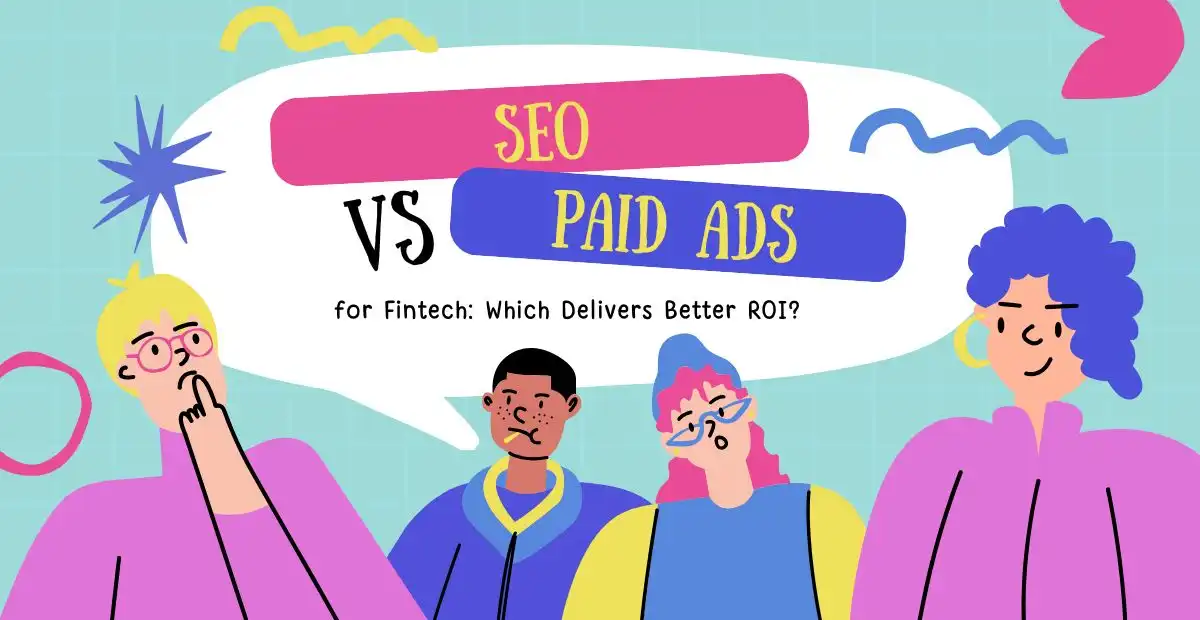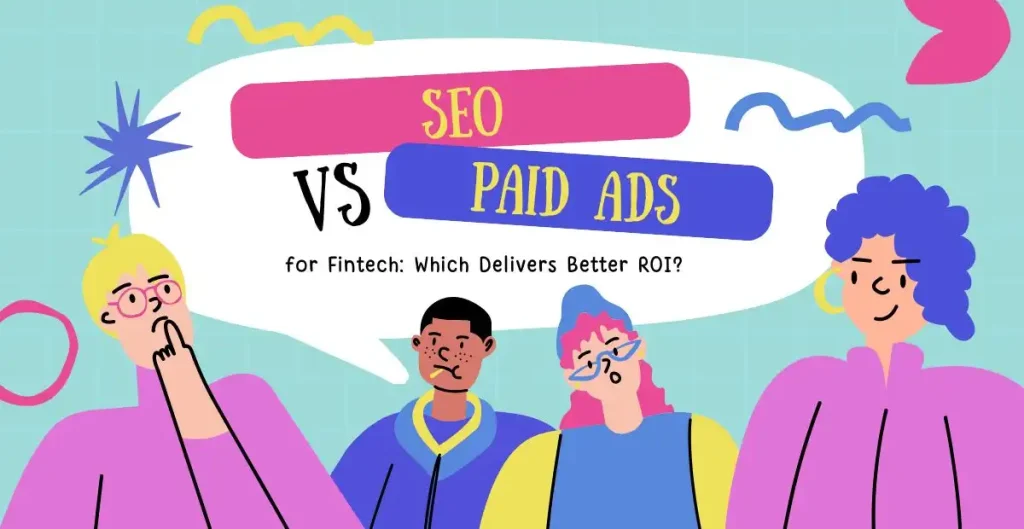
SEO vs Paid Ads for Fintech: Which Delivers Better ROI?
Table of Contents
In today’s competitive financial technology (fintech) industry, reaching the right audience at the right time is critical. Fintech startups and established players alike face one big challenge—how to maximize ROI on marketing spend. Two major digital marketing strategies dominate the landscape: SEO (Search Engine Optimization) and Paid Ads (like Google Ads, Meta Ads, LinkedIn Ads, etc.).
But which one delivers better ROI for fintech companies?
At Digiwalebabu, we specialize in SEO services in India, and we’ve worked with numerous fintech businesses to scale their online visibility and revenue. In this article, we’ll explore SEO vs Paid Ads in-depth, compare their strengths and weaknesses, analyze ROI potential, and finally determine which one fintech firms should prioritize.

What is SEO for Fintech?
SEO (Search Engine Optimization) is the process of optimizing a fintech website to rank organically on search engines like Google, Bing, and Yahoo. Instead of paying for every click, SEO helps fintech companies earn traffic through keyword targeting, content marketing, backlinks, and technical optimization.
For example: If someone searches “best loan apps in India” or “how to open a digital savings account,” a fintech brand that has invested in SEO can appear at the top of search results without paying for ads every time someone clicks.
At Digiwalebabu, our SEO services in India focus on building long-term organic growth for fintech businesses.
What are Paid Ads for Fintech?
Paid Ads, often called PPC (Pay-Per-Click) campaigns, allow fintech companies to display their services in front of potential customers instantly. Platforms like Google Ads, Facebook Ads, Instagram Ads, and LinkedIn Ads help target specific audiences based on demographics, interests, and search behavior.
For example: A loan app can run Google Ads for “instant personal loan” and appear above organic results immediately. Similarly, a new fintech wallet can run social media ads targeting 18–35-year-olds interested in digital banking.
Paid ads are quick and scalable, but they come with continuous costs. Once you stop paying, visibility disappears.
SEO vs Paid Ads: The Core Differences
| Factor | SEO (Search Engine Optimization) | Paid Ads (PPC) |
| Cost Model | Investment in content, optimization & backlinks | Pay for every click or impression |
| Timeframe for Results | 3–6 months minimum | Immediate |
| Traffic Type | Organic (long-term) | Paid (short-term) |
| Trust & Credibility | High – users trust organic results | Lower – ads are often ignored |
| Scalability | Long-term exponential growth | Scales as per budget |
| ROI Stability | High over time | Declines if ad spend reduces |
Both methods have strengths, but for fintech businesses, choosing the right strategy can mean the difference between sustainable growth and wasted marketing spend.
Why Fintech Businesses Need SEO
Fintech is one of the fastest-growing industries in India and worldwide, with new players emerging every day. Standing out requires not just flashy ads but a solid digital presence.
Here’s why SEO is crucial for fintech:
- High Search Demand: Keywords like “best trading apps in India”, “personal loan without CIBIL check”, and “credit card with no joining fee” get millions of monthly searches. Ranking for them means consistent leads.
- Trust Factor: Users trust organic search results more than ads. A fintech brand ranking on page 1 automatically builds credibility.
- Cost Efficiency: With SEO services in India, fintech companies can reduce long-term customer acquisition costs compared to the ever-rising costs of PPC.
- Content Power: Blogs, guides, and case studies in fintech can position a brand as a thought leader, which ads alone cannot achieve.
- Sustainability: Once ranked, organic listings bring traffic even if you pause campaigns—unlike Paid Ads.
Why Fintech Businesses Use Paid Ads
Despite its cost, Paid Ads also hold value in fintech marketing.
- Instant Visibility: SEO takes time, but ads give fintech brands immediate exposure. For example, launching a new loan app and running ads can bring installs on day one.
- Precise Targeting: Paid Ads allow you to target audiences based on income levels, locations, behaviors, and search history. For fintech products like insurance or trading apps, this is a big advantage.
- Scalability: If a fintech firm has deep pockets, scaling Paid Ads campaigns is easy.
- Testing Tool: Ads are great for testing product-market fit before investing in long-term SEO strategies.
- Brand Awareness: Even if users don’t click, appearing on top through ads creates awareness.
Cost Comparison: SEO vs Paid Ads in Fintech
Let’s break it down:
- SEO Costs (via SEO services in India):
- Initial audit and setup: ₹40,000–₹80,000 (one-time)
- Monthly optimization & content: ₹50,000–₹1,50,000
- Long-term benefits: Traffic keeps coming without extra cost per click.
- Paid Ads Costs:
- Google Ads CPC for fintech: ₹40–₹250 per click (highly competitive niche).
- Facebook/Instagram Ads CPM: ₹300–₹600 per 1000 impressions.
- Continuous spending required—stop paying, traffic vanishes.
Over 12 months, SEO services in India cost less than Paid Ads while bringing better ROI for fintech brands.
ROI Analysis: SEO vs Paid Ads
ROI (Return on Investment) is the ultimate measure of success.
- SEO ROI for Fintech:
- Long-term exponential growth.
- Lower acquisition costs as rankings stabilize.
- A single well-ranked keyword can bring thousands of leads every month.
- Paid Ads ROI for Fintech:
- Immediate but costly.
- Competition drives CPC higher every year.
- ROI declines unless budgets scale aggressively.
Case Example:
A fintech loan app invests ₹1,00,000 monthly in Paid Ads, generating 2000 leads at ₹50 per lead. When they stop ads, leads drop to zero.
The same app invests in SEO services in India for 6 months. By month 7, it starts generating 5000 organic leads/month without additional ad spend. The cost per lead keeps dropping as organic traffic grows.
Clearly, SEO wins in the long run.
Challenges of SEO for Fintech
- Time-Consuming: SEO takes 3–6 months to show results.
- High Competition: Fintech keywords are among the most competitive.
- Continuous Updates: Google algorithm updates can affect rankings.
- Content Sensitivity: Financial content must meet E-E-A-T (Experience, Expertise, Authoritativeness, Trustworthiness) standards.
At Digiwalebabu, our SEO services in India focus on overcoming these challenges through fintech-specific strategies.
Challenges of Paid Ads for Fintech
- Expensive Clicks: Fintech is one of the highest CPC industries.
- Ad Fatigue: Users often ignore repetitive ads.
- Compliance Restrictions: Some fintech ads get flagged by Google or Facebook due to strict financial guidelines.
- Short-Term Dependency: Once you stop ads, traffic disappears.
Long-Term Benefits of SEO for Fintech
- Evergreen Visibility: Ranking on keywords like “best loan app” keeps generating leads for years.
- Brand Authority: High-ranking content boosts trust in your fintech brand.
- Lower CAC (Customer Acquisition Cost): SEO reduces long-term cost per lead.
- Sustainable ROI: Unlike ads, SEO brings continuous returns.
This is why our clients at Digiwalebabu choose SEO services in India over heavy ad spends.
When to Use Paid Ads in Fintech
Paid Ads play a strategic role in fintech marketing, especially when quick results are needed. They are most effective in:
- Product Launches: Ideal for creating instant visibility and driving user acquisition right after launch.
- Seasonal Campaigns: Useful for promoting time-sensitive offers like insurance discounts during tax season.
- Testing Market Fit: Helps validate new fintech products quickly by measuring user response before scaling.
- Competitor Bidding: Allows brands to capture attention from users actively searching for competitors.
However, these campaigns should be used alongside SEO services in India for long-term growth, not as a replacement.
SEO + Paid Ads: The Hybrid Approach
The best strategy for fintech companies is often a mix of SEO and Paid Ads.
- Short-Term: Use Paid Ads for immediate results.
- Long-Term: Invest in SEO for sustainable growth.
- Synergy: Paid Ads data (keywords, audiences) can improve SEO targeting.
At Digiwalebabu, we help fintech firms balance SEO services in India with PPC campaigns to maximize ROI.
Why Choose Digiwalebabu for Fintech SEO?
At Digiwalebabu, we specialize in SEO services in India tailored for fintech businesses. Our expertise includes:
- Keyword Research for Fintech: Targeting high-intent terms like “best digital wallet in India” or “instant loan apps.”
- Content Marketing: Creating SEO-rich blogs, guides, and landing pages.
- Technical SEO: Optimizing fintech websites for speed, security, and compliance.
- Link Building: Acquiring authority backlinks from financial publications.
- Analytics & Reporting: Transparent ROI-driven SEO strategies.
With us, fintech brands can expect sustainable growth, higher trust, and maximum ROI.
Frequently Asked Questions About SEO Services in India for Fintech ROI
Which is better for fintech—SEO or Paid Ads?
SEO is better for long-term ROI as it builds trust and generates consistent organic traffic, while Paid Ads are useful for quick visibility. A balanced strategy often works best.
How long does SEO take for fintech companies?
On average, fintech companies see results in 3–6 months with consistent efforts. However, with expert SEO services in India, results can be accelerated depending on competition and keyword targeting.
Are Paid Ads too expensive for fintech brands?
Yes, fintech is a highly competitive sector with high CPCs. Paid Ads can quickly drain budgets if not optimized properly, unlike SEO which compounds value over time.
Can SEO alone drive leads for fintech businesses?
Yes, SEO can bring highly qualified leads, especially if content, technical SEO, and backlinks are well-optimized. Many fintech startups rely primarily on organic search for sustainable growth.
When should fintech companies use Paid Ads?
Paid Ads are ideal for product launches, seasonal campaigns, market testing, or competitor bidding—but they should complement, not replace, SEO.
What is the ROI difference between SEO and Paid Ads?
Paid Ads deliver instant ROI but stop once the budget ends. SEO, on the other hand, builds long-term ROI by consistently attracting free organic traffic.
Why are SEO services important for fintech in India?
India’s fintech market is rapidly growing, and competition is intense. Professional SEO services in India help fintech brands stand out, rank for high-intent keywords, and attract qualified customers.
How does Digiwalebabu help fintech brands with SEO?
At Digiwalebabu, we specialize in data-driven SEO strategies for fintech, including keyword research, content optimization, technical SEO, and link building to maximize ROI.
Can I combine SEO and Paid Ads for fintech marketing?
Absolutely! Using Paid Ads for quick wins and SEO for long-term visibility ensures your fintech brand gets both instant traction and sustainable growth.
Is SEO more cost-effective than Paid Ads in fintech?
Yes, SEO is far more cost-effective in the long run since it reduces dependency on ad spend while building brand authority and organic visibility.
Final Thoughts
In the fast-paced fintech world, the question isn’t about SEO vs Paid Ads, but how smartly you combine both. Paid Ads can give your fintech brand instant exposure, but SEO builds authority, trust, and compounding returns over time. If you’re serious about long-term growth and sustainable ROI, investing in SEO services in India is the smarter move—while using Paid Ads strategically to accelerate short-term goals.
At Digiwalebabu, we help fintech companies strike this perfect balance, ensuring every marketing dollar drives measurable results.
